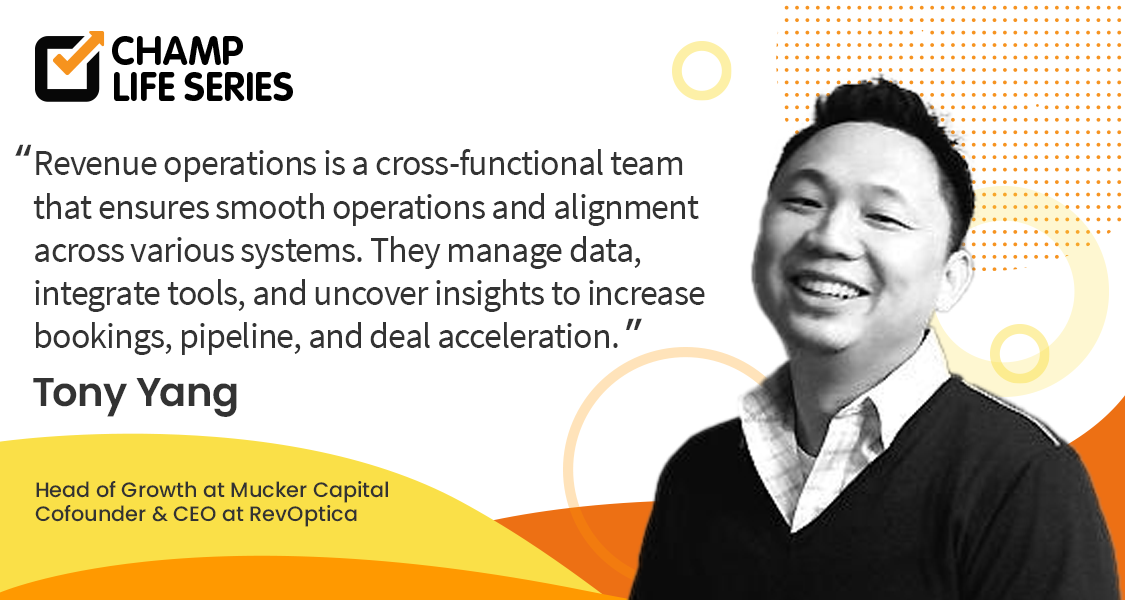In the realm of revenue operations and marketing, Tony stands out as a dynamic and versatile professional. As the Head of Growth at Mucker Capital, co-founder & CEO of RevOptica, and a fractional CMO & Marketing Consultant, he brings a strategic mindset and a diverse skill set to the table.
With over 15 years of experience in startups, technology, and B2B SaaS companies, Tony has held various leadership roles, including head of marketing and VP of marketing. Throughout his career, he has successfully navigated the interplay between sales-led and product-led growth, particularly in the complex landscape of targeting enterprise customers.
Tony’s expertise extends beyond marketing to encompass sales operations and revenue operations (rep ops). His deep understanding of these functions enables him to align sales, marketing, and customer success teams within a RevOps framework. By fostering collaboration and implementing streamlined processes, Tony ensures that these critical areas work in harmony to drive sustainable growth and deliver exceptional value to customers.
Moreover, Tony has a keen eye for identifying and implementing key performance indicators (KPIs) that effectively measure the success of RevOps initiatives. Drawing on his data-driven approach, he leverages analytics and metrics to assess the effectiveness of strategies, optimize performance, and drive continuous improvement. Join us as we explore Tony’s multifaceted journey and discover how he continues to redefine boundaries in the world of revenue operations, growth marketing, and marketing operations.
Can you explain the concept of RevOps and its significance in driving revenue growth and operational efficiency?
Rev Optica, it’s a buyer journey analytics and visualization tool. And it’s solving a pain point and challenge I’ve experienced for the better part of my career. I’ve worked in various startups, technology, and B2B SaaS startups for over 15 years. Sixteen. Sixteen.
Yeah, I’d lose track of time. Anyway, at these companies, my role has typically been the head of marketing, the VP of marketing, the one in charge of growth, the manager, or whatever you want to call it. And then later on in my career, I had the privilege of building up and managing inside sales teams, STRs, and BDRs. And then, throughout that entire career, I just wore the marketing operations hat and then sales ops rev ops, which people call rep ops today.
How would you collaborate with cross-functional teams to ensure smooth implementation and adoption of RevOps practices and technologies?
One of my main challenges, particularly during my time at B2B companies, is the interplay between sales-led and product-led growth. Product growth has gained significant traction in recent times, but it’s not entirely new. I’ve witnessed companies that embrace both product-led and sales-led growth. However, in organizations where sales take the lead, complexity arises from multiple stakeholders involved in the evaluation process.
This complexity intensifies when targeting enterprise customers, resulting in longer sales cycles. A major hurdle is comprehending how buyers engage with the brand, as there are various decision-makers. It can be arduous to piece together a holistic view of an account before closing a deal.
These circumstances have implications for aspects like attribution, a critical concern for growth marketers and demand-gen marketers in the B2B space. We are held accountable for generating a specific number of leads, and now, we’re often responsible for influencing opportunities in the pipeline. Understanding the buyer journey amidst the complexity of the sales process has been the driving force behind the idea of Rev Optica. It’s something I’ve contemplated for a long time and have recently started working on with my co-founders as a side project during nights and weekends to bring it to life.
Can you share a specific example of how you have successfully optimized the sales funnel or customer lifecycle through RevOps practices?
Revenue operations have gained significant exposure in recent years. Let me provide a brief overview of how I got involved in this field. After finishing business school in 2000, I joined a small startup as the sole marketing employee. During that time, I implemented Pardot, an early marketing automation tool, to automate email marketing and integrate campaigns on digital platforms.
In subsequent roles, I adopted Marketo for marketing automation, generating demand, and supporting sales teams. As marketing automation evolved, I recognized the need to streamline workflows, data enrichment, and integration between various tools like CRM and data providers.
Over time, my focus shifted from supporting campaigns to optimizing internal go-to-market processes, including data management and technology integration. Understanding what works and what doesn’t led me to delve into marketing operations analytics and collaborate closely with sales teams. This journey ultimately led me to own the entire function of revenue operations, aiming to eliminate silos and align go-to-market teams. Revenue operations serve as the glue that unifies teams by aligning language, definitions, and metrics.
How would you employ key strategies or methodologies to align sales, marketing, and customer success teams within a RevOps framework and identify/implement key performance indicators (KPIs) to measure the success of RevOps initiatives?
When it comes to KPIs for revenue operations, the main focus is on net new bookings or overall bookings, which refers to sign contracts that may have different payment schedules. This aligns with the goal of driving top-line growth. Additionally, a crucial metric for go-to-market teams utilizing a sales-led approach is the sales pipeline, which represents the value and number of potential deals in progress. Revenue operations, far from being a mere support function, should be viewed as the engineers behind the complex machinery of the go-to-market teams.
They ensure smooth operations and alignment across various systems, such as CRM, marketing automation, sales engagement, and customer success platforms. Their responsibilities include data management, integrations, and uncovering insights related to the buyer journey, attribution, sales cycle optimization, deal acceleration, risk prediction, and revenue forecasting. Ultimately, the goal is to increase bookings, pipeline, and deal acceleration, with revenue operations playing a vital role in facilitating coordination and achieving shared objectives.
How do you stay updated on the latest industry trends and best practices in RevOps? Can you explain how you have applied such insights to improve processes or outcomes?
To stay updated with trends in revenue operations, I actively engage in communities and social platforms. I participate in various Slack channels such as Revenue Operations Alliance, Mopros, Marketing ops pros, rep ops coop, Wizards of Ops, Bling Data, and op stars. These communities provide valuable opportunities to learn from others and seek guidance on specific topics. For instance, if I need help with HubSpot, I can connect with HubSpot experts in these communities. Engaging in these communities not only facilitates learning but also exposes me to emerging trends. Commonly discussed topics include product-led growth (PLG) and its intersection with sales-led approaches.
I observe recurring conversations around how revenue operations can support and adopt a PLG strategy alongside existing go-to-market strategies. Understanding how to integrate product usage insights into go-to-market systems like CRM and marketing automation is one aspect of this trend. By actively participating in these communities and leveraging social platforms like LinkedIn, I can stay informed about emerging trends and engage with peers, exchanging opinions and seeking feedback. While books are valuable resources for emerging trends, I find communities and social platforms to be more effective in staying up to date.
How do you measure the impact and success of RevOps initiatives, and how do you communicate those results to stakeholders and leadership?
In the context of startup companies, the decision to establish a revenue operations (rep ops) team depends on various factors. As someone who advises startup companies on growth strategies, I typically find myself working closely with founders and early-stage companies. At this stage, when a company is building its minimum viable product (MVP) and has a small team, including three co-founders, there is usually no rep ops team in place. The focus is primarily on product development and finding product-market fit.
The situation is similar When advising portfolio companies in the seed stage or pre-Series A. Founders typically manage growth efforts themselves, potentially with one growth person or a few sales reps. Revenue operations are not a top priority as these companies are still focused on validating their product and market. Generally, revenue operations become a consideration when companies are further along in their growth journey, have achieved product-market fit, and have internal resources, such as experts in tools like HubSpot.
In my role as an advisor, I guide companies in implementing certain functionalities or processes related to revenue operations, such as lead scoring within a marketing automation tool. However, I don’t advise them to establish a full-scale revenue operations team, as it may not be necessary or financially feasible at that early stage. Instead, I suggest leveraging external resources like consultants or agencies to address specific needs.
In your experience, what are some common challenges organizations face when transitioning to a RevOps model, and how do you address those challenges?
To determine when it’s appropriate to implement a rep ops team, a rough guideline could be when a B2B SaaS startup reaches around $5 to $10 million in annual recurring revenue (ARR). However, it’s important to note that this ballpark figure may vary based on business models and company specifics. Ultimately, the decision should be based on the company’s growth stage, available resources, and the CEO or founder’s understanding of where to invest in growth.
In summary, for early-stage startups, the focus should be on product development and market validation. Revenue operations become more relevant as companies mature and have achieved a certain level of revenue. At earlier stages, it’s advisable to prioritize other areas of the go-to-market teams and consider leveraging external resources for specific revenue operations needs.
Can you describe a scenario where you had to prioritize conflicting objectives or demands within a RevOps framework? How did you handle it?
When starting a company, there are specific areas and stages that should be the focus at any given time. In the early stages, the primary goal is typically to develop a minimum viable product (MVP), prove product-market fit, and understand the target market, pain points, value proposition, and unique selling points. This involves positioning the message and identifying areas where initial demand or low-hanging fruit can be captured.
As the company gains traction, additional channels for growth can be explored and systematized. If the company adopts a product-led growth (PLG) motion, there are specific considerations related to the user experience and guide users to the “aha” moment. However, the topic of PLG requires a more in-depth conversation.
What are your thoughts on the future of RevOps and how it will continue to evolve in the coming years?
The appropriate timing for implementing a rep ops team depends on the specific stage, challenges, and unique characteristics of the company. Each startup is different, and the challenges faced by one company in a specific market at a particular stage may differ from those of another company in a different market. Therefore, there is no universal answer to the question of when to establish a rep ops team.
In summary, the timing and focus of a startup’s growth strategy depend on the stage of the company, its specific challenges, and market dynamics. It’s crucial to adapt the approach based on these factors, and there is no one-size-fits-all solution.






